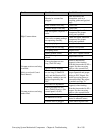
Conveying System Mechanical Components Chapter 6: Troubleshooting 94 of 138
Chapter 6: Troubleshooting
6-1 Introduction
The utmost in safety precautions should be observed at all times when working on or around
the machine and the electrical components. All normal trouble-shooting must be
accomplished with the power off, line fuses removed, and with the machine tagged as out of
service.
The use of good quality test equipment cannot be over-emphasized when troubleshooting is
indicated. Use a good ammeter that can measure at least twice the AC and DC current that
can be encountered for the machine. Be sure that the voltmeter has at least minimum
impedance of 5,000 OHMS-per-volt on AC and 20,000 OHMS-per-volt on DC scales.
Popular combination meters, VOM and VTVM can be selected to provide the necessary
functions.
Before making haphazard substitutions and repairs when defective electrical components are
malfunctioning, we recommend that you check the associated circuitry and assemblies for
other defective devices. It is common to replace the obviously damaged component without
actually locating the real cause of the trouble. Such hasty substitutions will only destroy the
new component. Refer to wiring diagrams and schematics.
Locating mechanical problems, should they occur, is relatively straightforward. When
necessary, refer to the parts catalog section.
Note: Refer to specific control panel operation and instruction manual for additional
details and Troubleshooting information.
Problem Possible Cause Possible Remedy
The motor overload tripped.
Reset the overload and check
the motor for the proper amp
draw as listed on the serial
tag.
No demand signal/stations
offline.
Check control panel.
Control panel problem.
Verify wire connections.
Inspect output cards.
Replace the fuse.
Main fuse in power drop or
optional fused disconnect
has blown.
Check for 3-phase voltage.
The pump doesn’t run even
though it is on line.
(Refer to enclosed Control
Panel Manual)
Motor contactor is faulty.
Repair or replace as
required.


















